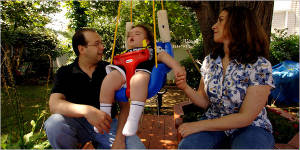|

|
| Joshua and Elizabeth Margulies with their son Benjamin who suffers from Tay Sachs. |
What is wrong is wrong with Bejamin?
Benjamin has Tay Sachs Disease, a fatal genetic disorder. Tay Sachs disease is an autosomal recessive condition associated
with progressive destruction of the central nervous system. The disease was described first in 1881 by Dr. Waren Tay and Dr.
Bernard Sachs, who noted a cherry-red spot on the retina in profoundly developmentlaly delayed children of eastern European
Jewish descent (Ashkenazi Jews). The disease is also common among French-Canadians from the Lac Saint Jean region and some
Cajuns of Louisiana.
Tay Sachs Disase (TSD) is caused by the absence of the enzyme hexosaminidase A (Hex-A), encoded on chromosome 15.
This enzyme is needed to break down acidic fatty compounds known as gangliosides. In a child with TSD, because of the Hex-A
deficiency, gangliosides, particularly the one called GM2, accumulate in the brain, interfering with nerve cell function,
leading to developmental delay and mental retardatoin. TSD is one of several neurodegenerative diseases called gangliosidosis.
These include Gaucher Disease, Niemann-Pick Disease, and Sandhoff Disease. Sandhoff disease is the most closely related to
TSD and is due to defficency of hexosaminidase A and hexosaminidase B.
How was Benjamin Diagnosed with TSD?
Benjamin was born a healthy nine pound baby, but his parents became alarmed when he was unalble to sit or hold his
head up by ten months and appeared to be blind.
Children with TSD are normal at birth but start to be different from other children at approximatley six months of
age. Progressive mental and motor deteriation is accompanied by seizures, paralysis, deafness, blindness, and death between
three and five years of age.
Diagnosis is suggested by the finding of a cherry-red spot on the retina as described by Doctor Tay. This finding
can occur in other gangliosedes including Sandhoff's Disease. TSD can be confirmed by blood enzyme assay showing low levels
or absence of Hex-A but normal levels of Hex-B. DNA tests can also be done to look for one of the fifty mutaions described
in the Hex-A gene in TSD. This DNA technique is very heldpful in identifying carriers of TSD who have normal levels of Hex-A.
What are possible treatments for Bejamin?
There is no cure and treatments are only symptomatic. These include antiseizure medication, gastrostomy tube for
feeding diffuclties, and nursing care to prevent bed sores.
Research is ongoing to find a cure by enzyme replacement. Because of succesful treatment of other gangliosidoses
by stem cell transplants, Benjamin's parents arranged for Benjamin to have a transplant. After this long and painful procedure,
Bejamin is stable, but blind, deaf and with difficult to control seizures. Benjamin is only two and a half years old; and
already his famiy and their insurance company have spent $2 million for his health care.
What can you do to help Benjamin?
Contributions to help with research into a cure for Tay Sachs disease can be made to the Tay Sachs Foundation.
Contributions can also be made to Dor Yeshorim (Hebrew for generation of the righteous). This organization founded by Rabbi
Joseph Eckstein, who had four children with TSD, provides funds for DNA testing of Ashkenazi Jews in Israel and North America.
|

